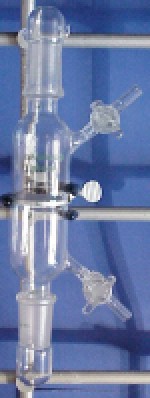
last updated

A frit or fritted funnel is a typical filtration device for the filtrations under an inert gas atmosphere. They are available in different sizes and setups. The basic model consists out of a glass tube, two joints (usually both male), two sidearms (stopcocks) and a frit (white part) in the middle part. The frit consists of a ceramic material, which can be of different porosities (Course, Medium, Fine). The experimenter has to think ahead of time which size and porosity is needed. A frit, which is tighter than necessary, will unnecessarily slow down the filtration. If the porosity is too high, fine precipitates will run through it, which will ultimately force you to perform another filtration using a finer frit. It is crucial that the fritted part is thoroughly cleaned and dried (in oven). Generally, a course frit works well for crystalline materials, while a fine frit is needed for fine powders like sodium chloride (out of reactions), etc. Like other Schlenk ware, the Schlenk frit has to be flame-dried prior use. The fritted part should not be heated excessively because it tends to crack due to the different expansion coefficients of glass and ceramic materials. The best way is to place the frit in a hot oven without stopcock plugs, take it out and assemble the filtration setup quickly, and then connect it to the vacuum line as fast as possible at the upper outlet.